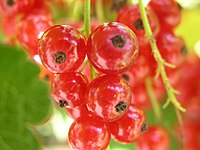
Photo from wikipedia
The Erzincan plain is one of the richest regions in Turkey in terms of plant biodiversity. In this region, the famous grape cultivar ‘Karaerik’ has always dominated grape production due… Click to show full abstract
The Erzincan plain is one of the richest regions in Turkey in terms of plant biodiversity. In this region, the famous grape cultivar ‘Karaerik’ has always dominated grape production due to its berry characteristics. The cultivar shows great morphological variation at clonal level. In this study, the total phenolic content and antioxidant activity of peel, pulp and seed extracts of nine ‘Karaerik’ clones sampled from same location were investigated. The Folin–Ciocalteu method was used to determine the total phenolic content of peel, pulp and seed extracts of nine clones. To determine antioxidant activity, three well known assays such as DPPH (2,2-diphenyl-1-picryl-hydrazyl-hydrate), FRAP (Ferric Reducing Antioxidant Power) and TEAC (Trolox Equivalent Antioxidant Capacity) were used. In addition, the correlation between total phenol content and DPPH, FRAP and TEAC was determined. Results showed that among the tissues, seed samples in berries of all clones had the highest total phenol content and antioxidant activity determined by three assays. Seed samples were followed by peel and pulp for total phenolic content and antioxidant activity. Among the nine ‘Karaerik’ clones, Clone 8 had the highest total phenolic content (149 mg GAE/100 g FW) while Clone 3 had the lowest (111 mg GAE/100 g FW). Peel, pulp and seed samples of nine ‘Karaerik’ clones showed strong antioxidant activity in DPPH, FRAP and TEAC assays. In particular, grape seeds were found rich for better in phenolic compounds including gallic acid, quercetin, catechin, chlorogenic acid, caffeic acid and p-coumaric acid. Clones such as 7, 8 and 9 higher antioxidant activity may present great potential for grape breeders and the food industry as well as health-conscious consumers.
Journal Title: Plants
Year Published: 2021
Link to full text (if available)
Share on Social Media: Sign Up to like & get
recommendations!